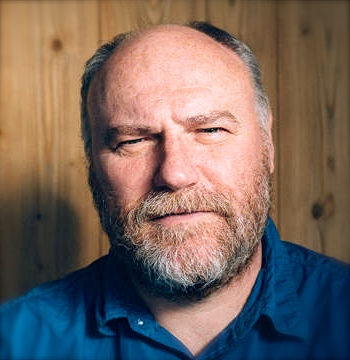“The road to Balinnie took them through Royston, then Provanmill. Long rows of dirty, black tenements lined the way interrupted by empty sites full of mud and piles of old tiles and bricks, any metal or lead from the roofs long gone. Driving through the north of Glasgow, a place he’d known since he was a boy, was like driving through a different city now. All the landmarks were gone, couldn’t find his way any more. All that was left…was a few rows of tenements. Motorways and shitty high flats. The New Glasgow.”
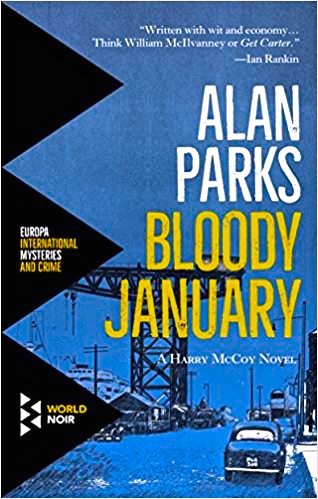 Alan Parks lived for years in Glasgow, Scotland, the place where he has set his debut novel – and the same place where revered author William McIlvanney set his three Laidlaw novels between the mid-1970s and the early 1990s. McIlvanney, credited as the founder of “Tartan noir,” casts a wide shadow with his Scottish writing, not only as a novelist, but also as a poet, a writer of literary fiction, a journalist, and a writer of screenplays, and publishers and some recent critics have drawn favorable comparisons between McIlvanney and Parks. Though both novelists have written dark, noir novels about Glasgow’s underworld and its subcultures, those familiar with McIlvanney will find few similarities to Parks, once they look beneath the surface. Parks is uncompromisingly realistic in his vision of the city, its gangs, its poor, and its corruption, whereas McIlvanney fills his narrative with unique descriptions and literary references, while also revealing the sad realities of his characters. Parks illustrates the weaknesses of his main characters – their alcohol dependence, use of drugs, and willingness to compromise in one legal area in order to achieve what they want in other areas. McIlvanney’s Laidlaw holds to his own truths. While Parks employs some local dialect and intersperses that language with a flood of four-letter descriptives which often dominate the dialogue, Mclvanney uses so much dialect that it often requires the reader to “translate” what the characters are saying in their “foreign language.”
Alan Parks lived for years in Glasgow, Scotland, the place where he has set his debut novel – and the same place where revered author William McIlvanney set his three Laidlaw novels between the mid-1970s and the early 1990s. McIlvanney, credited as the founder of “Tartan noir,” casts a wide shadow with his Scottish writing, not only as a novelist, but also as a poet, a writer of literary fiction, a journalist, and a writer of screenplays, and publishers and some recent critics have drawn favorable comparisons between McIlvanney and Parks. Though both novelists have written dark, noir novels about Glasgow’s underworld and its subcultures, those familiar with McIlvanney will find few similarities to Parks, once they look beneath the surface. Parks is uncompromisingly realistic in his vision of the city, its gangs, its poor, and its corruption, whereas McIlvanney fills his narrative with unique descriptions and literary references, while also revealing the sad realities of his characters. Parks illustrates the weaknesses of his main characters – their alcohol dependence, use of drugs, and willingness to compromise in one legal area in order to achieve what they want in other areas. McIlvanney’s Laidlaw holds to his own truths. While Parks employs some local dialect and intersperses that language with a flood of four-letter descriptives which often dominate the dialogue, Mclvanney uses so much dialect that it often requires the reader to “translate” what the characters are saying in their “foreign language.”
In fact, the differences between these authors outweigh the similarities, though both show the underside of Glasgow life. McInnerney is a realist; Parks is a naturalist – or as one of my teachers said many years ago, “The realists called a spade a spade; the naturalists called it a goddamn shovel.” Parks’s naturalistic description begins with the novel’s opening paragraph. It is 1973, and Det. Harry McCoy, just thirty, has been summoned to Barlinnie Prison, a Victorian building which houses many more prisoners than it was ever built for. “No wonder the whole prison stank. The smell of overflowing slop buckets and stale sweat was so thick it caught in the back of your throat as soon as the big doors opened; stuck to your clothes when you left.” He is meeting Howie Nairn, a convict confined to the Special Unit who has not admitted to a murder that he almost certainly committed. Nairn, however, has not called McCoy to discuss that. He wants to tell him that a girl named Lorna will be murdered the next day. All he knows about her is that she works in a “posh restaurant,” possibly Malmaison, and “someone’s gonnae do her tomorrow.” He doesn’t know her last name, but he feels that if he can do a favor for McCoy that his own position in jail might improve.
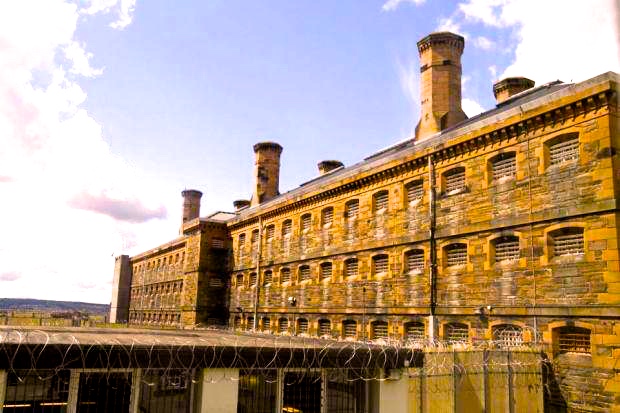
Barlinnie Prison, built in the Victorian period, and seriously overcrowded by 1973, when this novel takes place.
At this point, McCoy has worked a full day, night has fallen, and he needs some time off with Janey, his girlfriend. At the shebeen where she works and “where every room [is] converted to a bedroom apart from the kitchen,” he smokes dope, gets drunk, and decides he is “too stoned” to go anywhere looking for the mysterious Lorna. He does return to his job the next day, however, and, accompanied by Wattie, a young intern, he goes to the bus station and waits for her to arrive for work. Sudden shouts and a woman’s scream alert him to a teenage boy with a gun, and McCoy is not able to stop him from fatally shooting a woman – Lorna – then himself in the head. Upon returning to headquarters, McCoy and Wattie are sent back to the prison to find out how Nairn knew about the killing in advance .
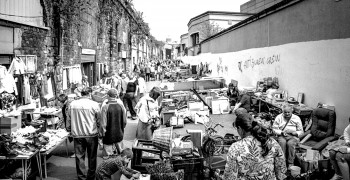
Paddy’s Market, “the market for people whose kids didn’t have shoes, whose tea was bread and jam or a bag of chips, if they were lucky.”
From this early scene, the action develops, day by day for the month of January, as does the picture of low-life Glasgow in 1973. By the third day, three people have died, and the true depths of depravity have only started to be revealed within a city which is dying: One neighborhood “was just motorways, half-demolished tenements with wallpapered rooms open to the sky and the odd pub left stranded in the middle of nowhere, everything around it gone.” As McCoy investigates Lorna’s life, he begins to show some real feeling about the people with whom he is in contact. Lorna’s friend, maybe her only real friend, inspires the first real sense here of McCoy’s sympathy for people in the grips of a lifestyle over which they have little or no control. His own issues regarding his health, his past, and his old friendships slowly emerge. Gradually, the involvement of “higher-ups,” both socially and within the police, shifts the focus upscale to the “important” Lord Dunlop and his son.
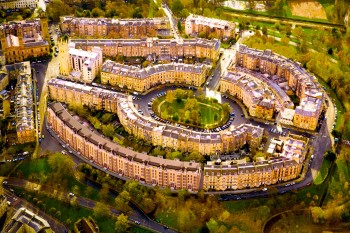
Park Circus, part of a series of grand Edwardian terraces, “a posh area,” where McCoy talks with “Madame Polo” about Lorna.
As McCoy begins to reveal his own past, his difficult childhood, family background, and early career become important for the reader. Murray, his boss, who has difficulty keeping him focused and directed, McCoy’s intern Wattie, and the reader eventually learn that McCoy’s court defense of an abused tramp who murdered someone in self defense led to the murder charge being reduced to culpable homicide and the sentence reduced to eighteen months. Since then McCoy “cannae walk down the street without some jakey (homeless person) shaking his hand telling him he’s a fucking hero.” Just when McCoy seems to be becoming more human, however, his very humanity makes him as vulnerable as those he wants to protect.
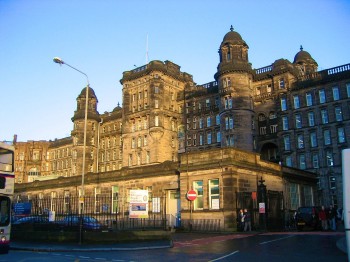
The Royal Infirmary in Glasgow, where a final scene sets up a continuation of this novel and its characters.
In the last fifty pages, sadistic violence against McCoy and others leads to a grand climax and more graphically described torture and bloodshed than the reader has seen in the previous two hundred fifty pages combined. The narrative is carefully constructed, but very graphic in its depiction of the setting and period, as it introduces a highly flawed, new “hero,” whose upcoming career in the “polis” seems set to develop in future novels.
ALSO by Parks: BOBBY MARCH WILL LIVE FOREVER, THE APRIL DEAD,
Photos. The author’s photo appears on https://www.europaeditions.com/
Barlinnie Prison, built during the Victorian Period, was already crowded in 1973, when this novel took place. http://www.heraldscotland.com
Paddy’s Market, “the market for people whose kids didn’t have shoes, whose tea was bread and jam or a bag of chips, if they were lucky.” http://www.chrisleslie.com/
Park Circus, part of a series of grand Edwardian terraces, “a posh area,” where McCoy talks with “Madame Polo” about Lorna. http://www.scottishconstructionnow.com/
The novel’s final scene at the Royal Infirmary in Glasgow summarizes the action and sets the scene for a future novel. https://en.wikipedia.org/wiki/Glasgow_Royal_Infirmary
